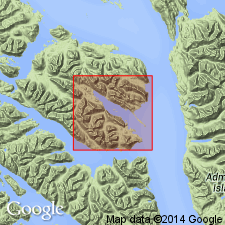
- Usage in publication:
-
- Iyoukeen formation*
- Modifications:
-
- Named
- Biostratigraphic dating
- Dominant lithology:
-
- Limestone
- Shale
- AAPG geologic province:
-
- Alaska Southeastern region
Summary:
Typically exposed on Iyoukeen Peninsula, northwest shore of Iyoukeen Cove and inland on ridges drained by Gypsum and Seal Creeks, Freshwater Bay area, northwestern Chichagof Island, southeastern AK. Extends from Iyoukeen Cove northwestward to north edge of map of Freshwater Bay area in vicinity of Spasski Creek in belt 2.5 to 3.5 mi wide. Divided into (ascending): 200 to 600 ft of dark-gray fossiliferous fine-grained thin-bedded limestone; 500 to 750 ft of dark-gray to grayish-black sparsely fossiliferous shale, and 3000 ft of fossiliferous dark- and light-gray medium-bedded limestone with nodular chert lenses. Maximum thickness is probably less than 4500 ft. Unconformably overlies Freshwater Bay formation (new). Near lower part of Wukuklook Creek underlies Kennel Creek formation (new) of Middle Devonian age which has probably been thrust over unit. Intruded by Gypsum Creek quartz monzonite (new). Is youngest pre-Quaternary rock unit in Freshwater Bay area. Age is Early and Late Mississippian based on ages of corals and brachiopods.
Source: GNU records (USGS DDS-6; Menlo GNULEX).
For more information, please contact Nancy Stamm, Geologic Names Committee Secretary.
Asterisk (*) indicates published by U.S. Geological Survey authors.
"No current usage" (†) implies that a name has been abandoned or has fallen into disuse. Former usage and, if known, replacement name given in parentheses ( ).
Slash (/) indicates name conflicts with nomenclatural guidelines (CSN, 1933; ACSN, 1961, 1970; NACSN, 1983, 2005, 2021). May be explained within brackets ([ ]).

